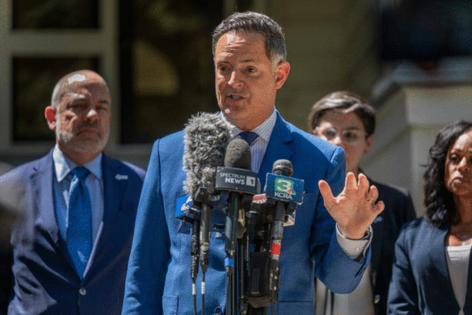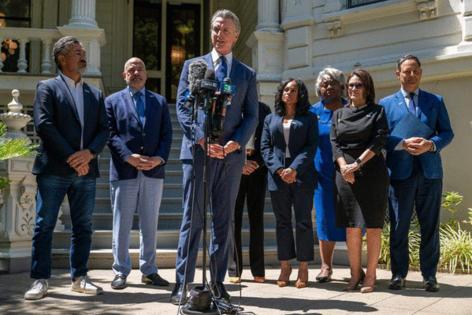Gov. Gavin Newsom presses for redistricting as he meets with Texas state Dems
Published in News & Features
Gov. Gavin Newsom further pressured state lawmakers to redraw congressional districts, as Democrats nationwide consider redrawing more favorable districts ahead of 2026 to shore up their chances of winning back congressional power after President Donald Trump urged Texas Republicans to guarantee him five more party seats in the midterm elections.
Leaders in Texas, Florida, California and New York — the states with the largest delegations — have floated the possibility of carving up districts to guarantee more members of their respective parties win office in the midterms. Democrats are hoping to make a political comeback then, while the GOP hopes to widen their razor-thin majority margin.
Newsom met Friday at the governor’s mansion in Sacramento with Democratic Texas state Reps. Ramon Romero, Rafael Anchía, Ana-María Rodríguez Ramos, Jessica González, Barbara Gervin-Hawkins, and Claudia Ordaz to discuss redistricting. California Democratic Reps. Zoe Lofgren and Ted Lieu also attended remotely, as did Sen. Alex Padilla, according to Newsom’s office.
Speaking to reporters afterwards, Newsom said the California Legislature was “kicking the tires” on possibly drawing their own congressional maps. He said he was also considering asking voters to restore redistricting power to the Legislature, effectively repealing a 2008 ballot initiative that granted that power to the independent Citizen Redistricting Commission starting in 2010.
“This is a fluid conversation that came, frankly, came in reaction to the phone call from Donald Trump to Greg Abbott in Texas, and the break the glass moment we’re in,” he said.“Everything’s on the line.”
Redistricting usually happens after the decennial Census count, to account for population changes. Republican Texas Gov. Greg Abbott ordered a special legislative session to redistrict after Trump’s request, motivating Newsom to find ways to do the same.
Anchía said he and other Texas Democratic state representatives would “use every tool” to fight redistricting in Texas, which has been challenged on several occasions for disenfranchising voters of color. A federal lawsuit in El Paso charging the state with voter discrimination is ongoing.
“I’m hearing from a lot of my Republican colleagues that they’re concerned, number one, (with) the president, the precedent that he set for them,” Anchía said. “They’re worried about cutting districts too thin in the state of Texas or their congressional delegation. So those things are present, and those are part of the discussions as we Democrats are going to use every tool in our toolbox to fight this unlawful redistricting.”
Last week, Newsom called the effort an existential threat to democracy as Trump has consolidated executive power, and in turn provides a way for Democrats to appease supporters who want them to match Republicans’ hardball tactics. Democrats need a net gain of three seats for control of the House.
“They’re (Republicans) playing by a different set of rules. They can’t win by the traditional games, so they want to change the game,” he told reporters in Los Angeles last Wednesday. “We can act holier than thou. We could sit on the sidelines, talk about the way the world should be, or we can recognize the existential nature that is this moment.”
It’s unclear if the California Democrat — reportedly eyeing a presidential run in 2028 — will succeed, even with a Democratic supermajority in the Legislature.
One way for state lawmakers to move forward would require wresting power from the independent state redistricting commission, which voters approved in 2008 to oversee redistricting. Another is to call a special election for legislators to redistrict, a theory Newsom said on his podcast that his attorneys believed would stand up to scrutiny, though it would be costly.
As recently as 2022, Newsom said he wanted the process to remain independent so that voters remained the final authority on choosing their representatives. California has 52 Congressional seats, 43 of which are held by Democrats. House Speaker Emerita Nancy Pelosi, D-Calif., said Friday she supported efforts to counteract Republican gerrymandering.
“I don’t like redistricting in the middle of a decade, but if that’s the game that Republicans want to play, we have to make sure that they know we’re going to put everything on the table,” she told NewsNation.
Michigan Sen. Elissa Slotkin, a Democrat, said she planned to “go nuclear” and “not fight with one arm tied behind my back” if Texas managed to eke out another five seats. The Lone Star State currently has 38 congressional seats, 25 of which are held by Republicans.
Common Cause California, a good governance group, said a special election would be “risky and expensive,” and that there was no legal standing for the Legislature to redistrict.
“Point blank, this is a dangerous move,”said executive director Darius Kemp in a statement. “We know independent redistricting works because California has been the national leader for years. We can’t afford to put our state’s democracy on the line during a time of national instability.”
Partisan power grab?
Republicans are now trying to paint Newsom’s pivot as a partisan power grab. Rep. Kevin Kiley, R-Roseville, called it “outrageous” and “corrupt” at his weekly Capitol news conference Thursday in Washington, D.C.
“It goes against what the people of our state have said they want,” he said. “If it does come to a vote again, I believe California voters will reaffirm their previous position. It’s truly a sign of how partisan this governor is that he’d be willing to go to these lengths to secure a further partisan advantage and to try to eliminate what semblance of checks and balances we have in California.”
Kiley is in his second term in a district rated “likely Republican” by nonpartisan analysts Inside Elections, the Cook Political Report and Sabato’s Crystal Ball.
The district runs from the northern Sierra Nevadas along the Nevada border into Death Valley. It includes Alpine, Inyo, Mono, Nevada, Placer, Plumas and Sierra counties and parts of El Dorado, Sacramento and Yuba counties. It’s a district that could easily be redrawn to stretch into Sacramento-area suburbs dominated by Democrats.
Kiley, long a Newsom nemesis, recalled how the independent commission was approved by voters.
“It’s rather undemocratic for the governor to now be talking about trying to override the work of an independent commission created through the democratic process by California voters,” he said. “Most people, regardless of what party they are, think that level of imbalance is not a healthy thing.”
Kiley said Newsom wants to cut the number of GOP members to three.
That’s not “the makeup of our state, where you tend to have 40% of the vote for Republicans or higher in statewide elections.” President Donald Trump won 38.3% of the California vote last year. Republican Steve Garvey won 41.1% in his losing Senate bid.
House Minority Leader Hakeem Jeffries, D-N.Y., was asked at his Capitol news conference this week about how he would deal with laws regarding independent commissions.
“We continue to have conversations with the state delegations in California or New York or beyond in order to explore what the opportunities are, in order to make sure that the congressional map in 2026 is as fair as possible,” he told reporters.
____
©2025 The Sacramento Bee. Visit at sacbee.com. Distributed by Tribune Content Agency, LLC.










Comments